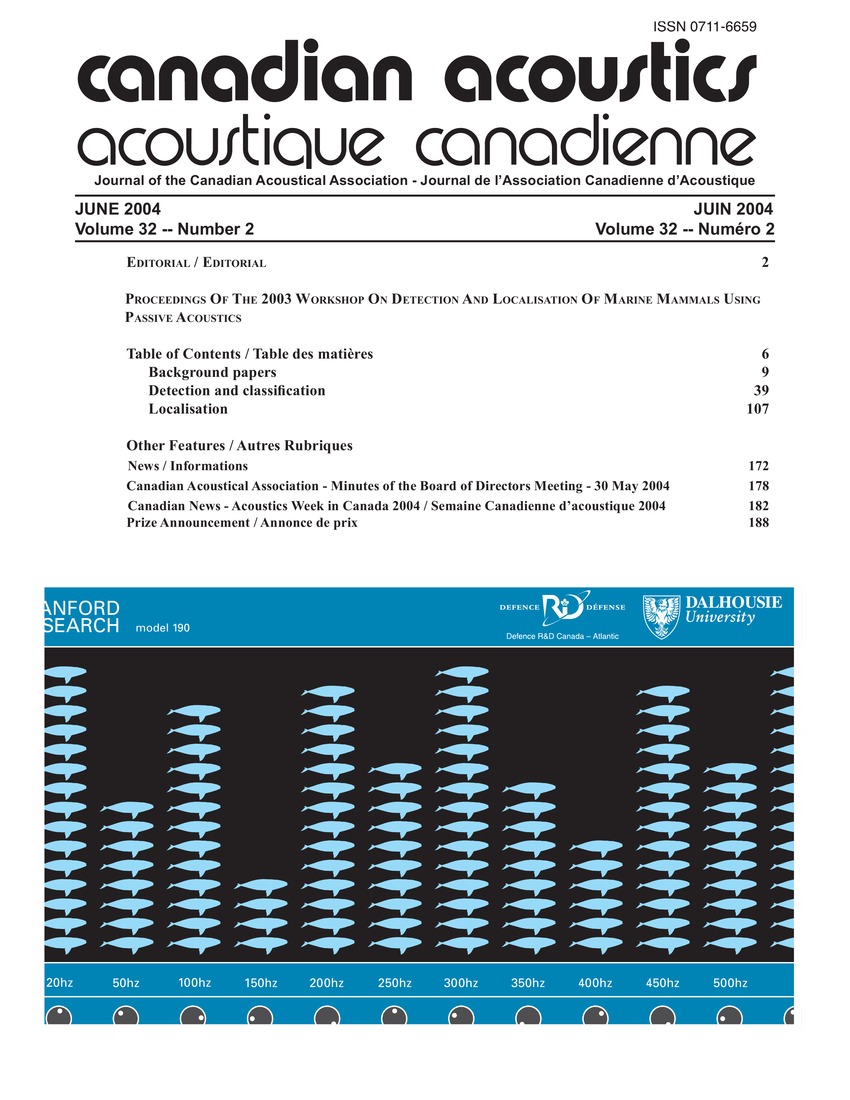Comparing a linear with a non-linear method for acoustic localization
Mots-clés :
Acoustic waves, Correlation methods, Error analysis, Nonlinear systems, Problem solving, Signal theory, Acoustic localization, Error bounds, Non-linear methods, Path geometryRésumé
La performance de deux méthodes différentes de localisation acoustique est évaluée à partir de la localisation acoustique des baleines franches dans la Baie de Fundy. Les méthodes sont comparées à l’erreur de localisation GPS (114-273 m) à partir de vocalisations de baleines franches préenregistrées. L’approche linéaire sous-estime l’erreur de localisation de la source sonore (22 m), alors que l’approche non-linéaire surestime l’erreur (462-1166 m). L’approche linéaire rend irréaliste la marge d’erreur possible à cause des propriétés non-linéaires du problème de localisation. L’approche non linéaire exagère la marge d’erreur, ce qui est expliqué par le choix du mauvais maximum de corrélation croisée des mesures de différences de temps d’arrivée. Toutefois, l’erreur de localisation GPS était toujours contenue à l’intérieur d’une marge d’erreur non-linéaire et n’était jamais contenue à l’intérieur d’une marge d’erreur linéaire de localisation. Ceci indique que l’approche non-linéaire peut donner des erreurs d’estimation plus justes, spécifiquement dans les situations où la trajectoire du son est inconnue.Fichiers supplémentaires
Publié-e
Comment citer
Numéro
Rubrique
Licence
Author Licensing Addendum
This Licensing Addendum ("Addendum") is entered into between the undersigned Author(s) and Canadian Acoustics journal published by the Canadian Acoustical Association (hereinafter referred to as the "Publisher"). The Author(s) and the Publisher agree as follows:
-
Retained Rights: The Author(s) retain(s) the following rights:
- The right to reproduce, distribute, and publicly display the Work on the Author's personal website or the website of the Author's institution.
- The right to use the Work in the Author's teaching activities and presentations.
- The right to include the Work in a compilation for the Author's personal use, not for sale.
-
Grant of License: The Author(s) grant(s) to the Publisher a worldwide exclusive license to publish, reproduce, distribute, and display the Work in Canadian Acoustics and any other formats and media deemed appropriate by the Publisher.
-
Attribution: The Publisher agrees to include proper attribution to the Author(s) in all publications and reproductions of the Work.
-
No Conflict: This Addendum is intended to be in harmony with, and not in conflict with, the terms and conditions of the original agreement entered into between the Author(s) and the Publisher.
-
Copyright Clause: Copyright on articles is held by the Author(s). The corresponding Author has the right to grant on behalf of all Authors and does grant on behalf of all Authors, a worldwide exclusive license to the Publisher and its licensees in perpetuity, in all forms, formats, and media (whether known now or created in the future), including but not limited to the rights to publish, reproduce, distribute, display, store, translate, create adaptations, reprints, include within collections, and create summaries, extracts, and/or abstracts of the Contribution.


